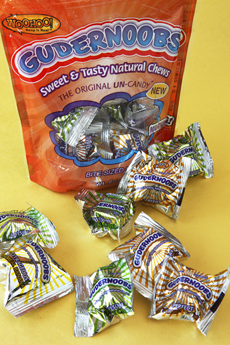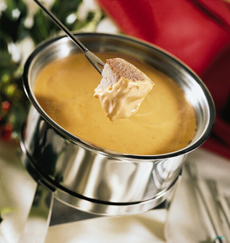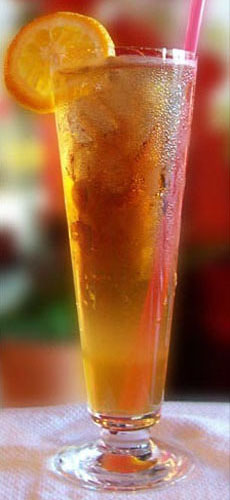|

[1] It’s iced tea season; brew a batch (photo © Tea Forte).

[2] Here, a Chemex drip coffee carafe has been repurposed to brew iced tea (photo © Regis Hari Bouchard | Unsplash).

[3] Don’t forget green tea, also delicious iced; and herbal tea, like the hibiscus and chamomile teas above (photo © Sun Basket).

[4] The domed ice house in of the Pitti Palace in Florence, Italy, the main seat of the Medici grand dukes of Tuscany. It is set on a shaded slope in the Boboli Gardens behind the palace, half-sunk into the ground.
|
|
As the weather grows warmer, our thoughts turn to iced tea. (June is National Iced Tea Month, June 10th is National Iced Tea Day).
Even though fine brewed tea continues to grow in popularity—and tea is the second most-consumed beverage in the world, after water—about 80% of the tea sold in the U.S. is bottled tea, generally consumed cold.
That’s an expensive way to consume tea, not to mention millions of bottles going into the landfill.
It’s time to B.Y.O.I.T.: brew your own iced tea. Save money and save the planet.
Keep a pitcher of iced tea in the fridge as a calorie-free beverage. In fact, keep two pitchers with two different types of tea—Earl Grey and Assam teas, peach tea and passion fruit tea, or any black and green teas.
We also keep the 16-ounce plastic water bottles that we pick up along the way, refill them with iced tea.
HOW TO BREW ICED TEA
You need to make iced tea stronger than regular tea to compensate for dilution from ice. Even if you don’t use ice, the coldness of refrigerated tea can suppress some flavor components; so stronger is better.
Another tip: The better the tea quality, the more enjoyable the tea. Some mass supermarket brands don’t have the best flavor (our favorite brand is Bigelow), and many people add MORE sugar to make the drink taste better.
Try making iced tea from the best tea, and see if you can enjoy it without sweetener. Eliminating sweetener allows you to taste the complexity of fine tea.
Ingredients Per Quart*
4 to 5 tea bags or teaspoons of loose tea
Tap or filtered water
Optional garnishes: lemon, lime, mint sprigs
Ice
Sweeteners of choice
Preparation
1. PLACE the tea into a pitcher or clean quart bottle for brewing. If using loose tea, enclose it in a tea ball/spice ball for easy clean-up.
2. BOIL 2 cups of cold water (tap water or filtered). Pour the boiling water into the pitcher and steep for 5 minutes. Remove the tea bags or strain the loose tea into another pitcher or receptacle. Add 2 more cups of cold water and refrigerate.
3. SERVE over ice with optional garnishes. We make our ice cubes from brewed tea so the tea never dilutes. Just pour room-temperature or chilled tea into an ice cube tray.
_____________________
*We brew two quarts at a time in a 64-ounce pitcher.
ICED TEA TIPS
Superfine sugar dissolves more easily in cold liquids than regular table sugar. You can purchase superfine sugar, or pulverize your table sugar in a spice grinder.
Think beyond the sugar and try agave nectar (also called agave syrup). It has a more elegant sweetness than sugar (which can be cloying), and mixes easily into cold beverages. While agave nectar contains virtually the same amount of calories as other liquid sweeteners like honey and maple syrup, it is far, far lower on the glycemic index.
Try giving up sweetener by adding fresh lime or lemon juice.
Plan for an iced tea party—a great way to socialize indoors or outdoors.
THE HISTORY OF ICED TEA (AND ICE FOR DRINKS!)
While drinking tea dates back thousands of years, ice to keep foods cold was available only to the wealthy few, who could afford ice houses.
During the winter, the ice house, built in a shaded area, sometimes below ground, would be loaded up with ice and snow and packed with insulation such as straw or sawdust. The original purpose was to store perishable foods in the warm months, but the ice could also be used to cool drinks or make ice cream and sorbet.
|
The earliest remains of ice pits found are from the seventh century B.C.E., with references suggesting that the techniques were used before the 11th century B.C.E.
During its heyday, commercial ice houses would store tons of ice for purchase. Still, ice houses only existed where there was a source of natural ice.
In 1806, Frederic Tudor, a New England entrepreneur, came up with the idea to export ice on a commercial basis. Barges of ice covered in sawdust were shipped in ancient times to hot places like the Middle East, but only on a minuscule scale, for kings and other people of great wealth.
Tudor’s first shipment was to the Caribbean, and the “Ice King” ultimately shipped ice all over the world. Tudor invented an entire industry, the ice trade.
Now to the invention of iced tea.
The drink didn’t appear on the scene until 1904, at the St. Louis World’s Fair.
An Englishman named Richard Blechynden was trying to sell tea as a refreshment, but the weather was very hot and no one was buying. As necessity is the mother of invention, he added ice to the tea, and the new refreshing drink was born.
In homes fortunate enough to have ice boxes cooled with a block of ice, pieces of the block were chipped off to cool drinks. The Domestic Electric Refrigerator, produced in 1914 by Fred Wolf, contained a simple ice cube tray.
By the 1920s and 1930s ice cube trays were commonplace in refrigerators. The home electric refrigerator didn’t arrive until 1930. Those who could afford it upgraded from an ice box
Here’s more history of iced tea.
|







